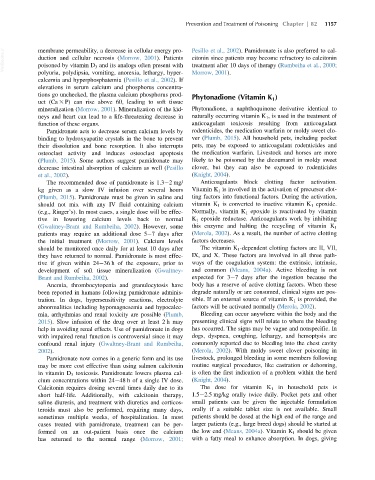Page 1226 - Veterinary Toxicology, Basic and Clinical Principles, 3rd Edition
P. 1226
Prevention and Treatment of Poisoning Chapter | 82 1157
VetBooks.ir membrane permeability, a decrease in cellular energy pro- Pesillo et al., 2002). Pamidronate is also preferred to cal-
citonin since patients may become refractory to calcitonin
duction and cellular necrosis (Morrow, 2001). Patients
poisoned by vitamin D 3 and its analogs often present with
treatment after 10 days of therapy (Rumbeiha et al., 2000;
polyuria, polydipsia, vomiting, anorexia, lethargy, hyper- Morrow, 2001).
calcemia and hyperphosphatemia (Pesillo et al., 2002). If
elevations in serum calcium and phosphorus concentra-
tions go unchecked, the plasma calcium phosphorus prod- Phytonadione (Vitamin K 1 )
uct (Ca 3 P) can rise above 60, leading to soft tissue
mineralization (Morrow, 2001). Mineralization of the kid- Phytonadione, a naphthoquinone derivative identical to
neys and heart can lead to a life-threatening decrease in naturally occurring vitamin K 1 , is used in the treatment of
function of these organs. anticoagulant toxicosis resulting from anticoagulant
Pamidronate acts to decrease serum calcium levels by rodenticides, the medication warfarin or moldy sweet clo-
binding to hydroxyapatite crystals in the bone to prevent ver (Plumb, 2015). All household pets, including pocket
their dissolution and bone resorption. It also interrupts pets, may be exposed to anticoagulant rodenticides and
osteoclast activity and induces osteoclast apoptosis the medication warfarin. Livestock and horses are more
(Plumb, 2015). Some authors suggest pamidronate may likely to be poisoned by the dicoumarol in moldy sweet
decrease intestinal absorption of calcium as well (Pesillo clover, but they can also be exposed to rodenticides
et al., 2002). (Knight, 2004).
The recommended dose of pamidronate is 1.3 2 mg/ Anticoagulants block clotting factor activation.
kg given as a slow IV infusion over several hours Vitamin K 1 is involved in the activation of precursor clot-
(Plumb, 2015). Pamidronate must be given in saline and ting factors into functional factors. During the activation,
should not mix with any IV fluid containing calcium vitamin K 1 is converted to inactive vitamin K 1 epoxide.
(e.g., Ringer’s). In most cases, a single dose will be effec- Normally, vitamin K 1 epoxide is reactivated by vitamin
tive in lowering calcium levels back to normal K 1 epoxide reductase. Anticoagulants work by inhibiting
(Gwaltney-Brant and Rumbeiha, 2002). However, some this enzyme and halting the recycling of vitamin K 1
patients may require an additional dose 5 7 days after (Merola, 2002). As a result, the number of active clotting
the initial treatment (Morrow, 2001). Calcium levels factors decreases.
should be monitored once daily for at least 10 days after The vitamin K 1 -dependent clotting factors are II, VII,
they have returned to normal. Pamidronate is most effec- IX, and X. These factors are involved in all three path-
tive if given within 24 36 h of the exposure, prior to ways of the coagulation system: the extrinsic, intrinsic,
development of soft tissue mineralization (Gwaltney- and common (Means, 2004a). Active bleeding is not
Brant and Rumbeiha, 2002). expected for 3 7 days after the ingestion because the
Anemia, thrombocytopenia and granulocytosis have body has a reserve of active clotting factors. When these
been reported in humans following pamidronate adminis- degrade naturally or are consumed, clinical signs are pos-
tration. In dogs, hypersensitivity reactions, electrolyte sible. If an external source of vitamin K 1 is provided, the
abnormalities including hypomagnesemia and hypocalce- factors will be activated normally (Merola, 2002).
mia, arrhythmias and renal toxicity are possible (Plumb, Bleeding can occur anywhere within the body and the
2015). Slow infusion of the drug over at least 2 h may presenting clinical signs will relate to where the bleeding
help in avoiding renal effects. Use of pamidronate in dogs has occurred. The signs may be vague and nonspecific. In
with impaired renal function is controversial since it may dogs, dyspnea, coughing, lethargy, and hemoptysis are
confound renal injury (Gwaltney-Brant and Rumbeiha, commonly reported due to bleeding into the chest cavity
2002). (Merola, 2002). With moldy sweet clover poisoning in
Pamidronate now comes in a generic form and its use livestock, prolonged bleeding in some members following
may be more cost effective than using salmon calcitonin routine surgical procedures, like castration or dehorning,
in vitamin D 3 toxicosis. Pamidronate lowers plasma cal- is often the first indication of a problem within the herd
cium concentrations within 24 48 h of a single IV dose. (Knight, 2004).
Calcitonin requires dosing several times daily due to its The dose for vitamin K 1 in household pets is
short half-life. Additionally, with calcitonin therapy, 1.5 2.5 mg/kg orally twice daily. Pocket pets and other
saline diuresis, and treatment with diuretics and corticos- small patients can be given the injectable formulation
teroids must also be performed, requiring many days, orally if a suitable tablet size is not available. Small
sometimes multiple weeks, of hospitalization. In most patients should be dosed at the high end of the range and
cases treated with pamidronate, treatment can be per- larger patients (e.g., large breed dogs) should be started at
formed on an out-patient basis once the calcium the low end (Means, 2004a). Vitamin K 1 should be given
has returned to the normal range (Morrow, 2001; with a fatty meal to enhance absorption. In dogs, giving

